Thin Wallet, Thick Boots
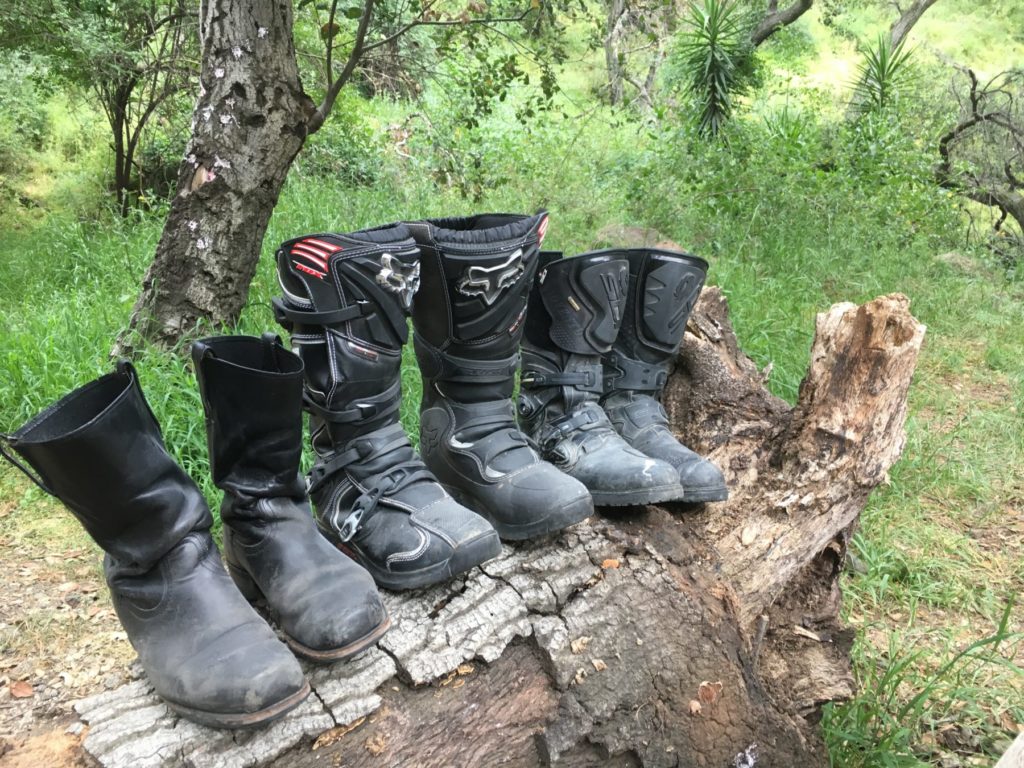
I’m a bit of a shoe snob, I’ll admit it, but with good reason. I’m extremely hard on shoes and can destroy a cheap pair in months – weeks if they’re a bargain-basement brand. I recall in high school buying my first pair of modern-style cowboy boots, a fancy pair of grey bonded leather, rubber sole and heel and vinyl shaft. Within weeks I’d poked a hole through the toes and a few months later had destroyed the soles beyond use-ability. In college I bought an expensive pair of Doc Martin’s based on rave reviews and within one month I’d collapsed the insole and worn out the outsole. Contrast that with my $400 Magnanni dress shoes which finally died after 8 years of hard use or my $300 Asolo hiking boots which are still plugging away after 6 years of mud, sand, scree, bouldering, crampons, rain and everything in-between. Hopefully my experience and financial pain will be a good guide for your choices.
Where this comes into play with motorcycling is that the quality of the shoe matters even more than just for style and longevity. Your very ability to walk away from an accident may be on the line. Having said that, I typically ride my street bike wearing a pair of Frye Harness boots with the harness cut off to look more like a cavalry boot.
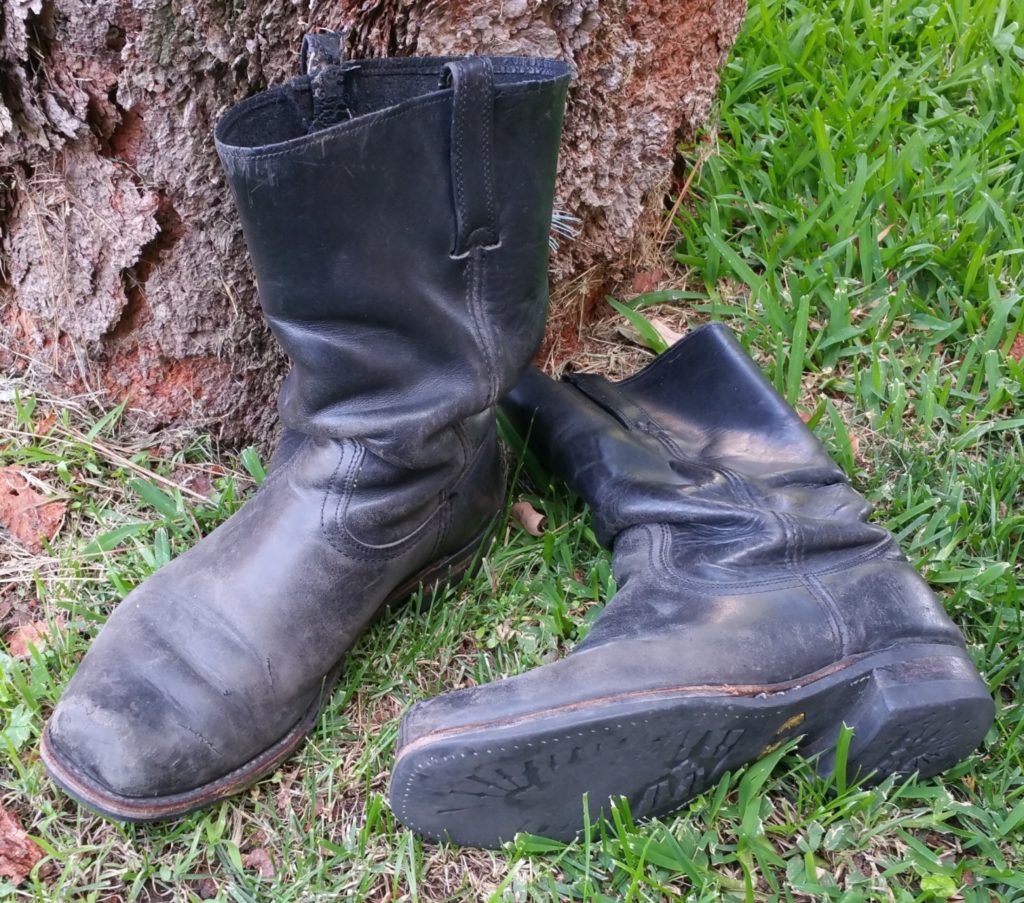
Not the best protection but no laces, a full shaft, a heel to grip the pegs and a sturdy Norwegian or Goodyear welt to an oil resistant outsole. Used to be somewhat reasonably priced at $200, but they seem to have gone up to $300+ now. I do have a pair of Chippewa Rally boots I’ve never worn but may have to use them now that my Frye’s are dying. 10 years, 50,000 miles and 3 outsoles later I guess I can bury them with pride.
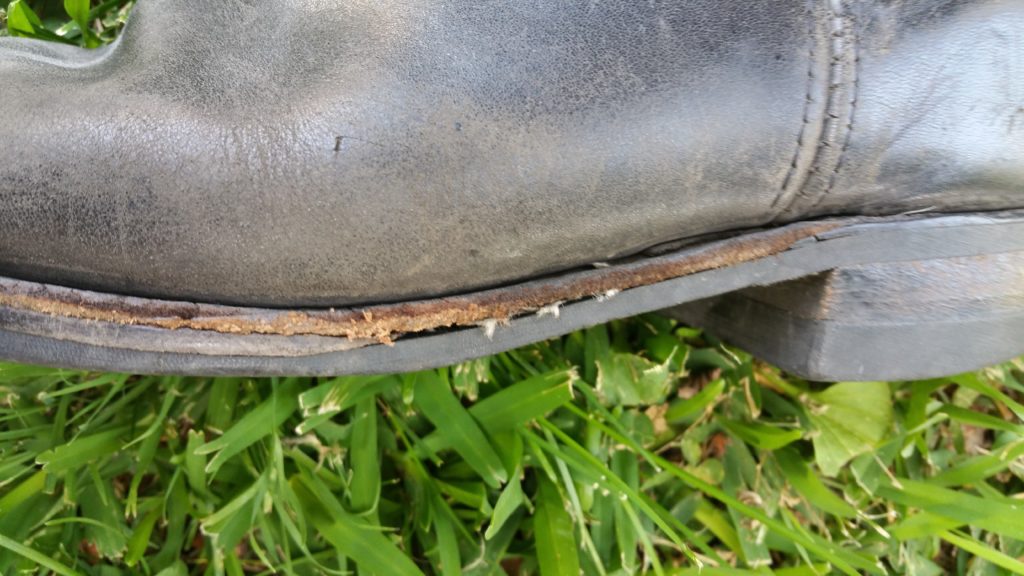
Soulful
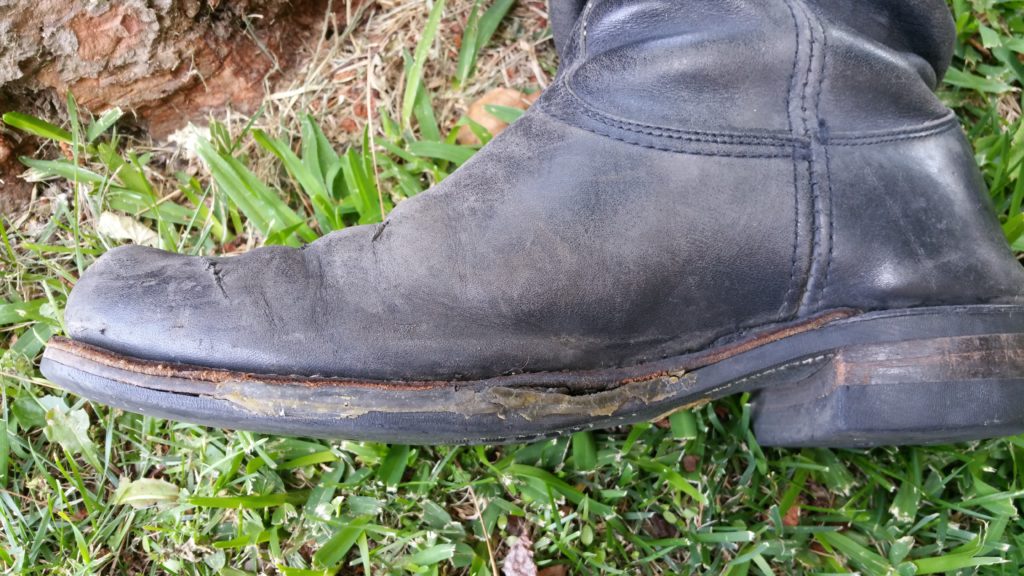
Soul Patch
When it comes to the dirt, I’m a lot less flippant, as dropping the bike and having it drop on you is not only possible, but likely. I’ve never dropped my sport bikes in 50K miles of riding, can’t say the same for my dual sports. Being new to dirt riding, I had to do a lot of research to figure out what was required for a cross country ride and a lot more research to figure out what would work for my odd body shape.
Let me start with the giant gorilla calf in the room: My calves measure roughly 19” in diameter, probably more when I’m in training for an event. After visiting 4 motorcycle stores in the area, including Bert’s Mega Mall and Chaparral, I eventually discovered that most dirt boots are not designed for the larger legged in the world. This was actually the defining factor for which boots I could buy and where I’d buy them.
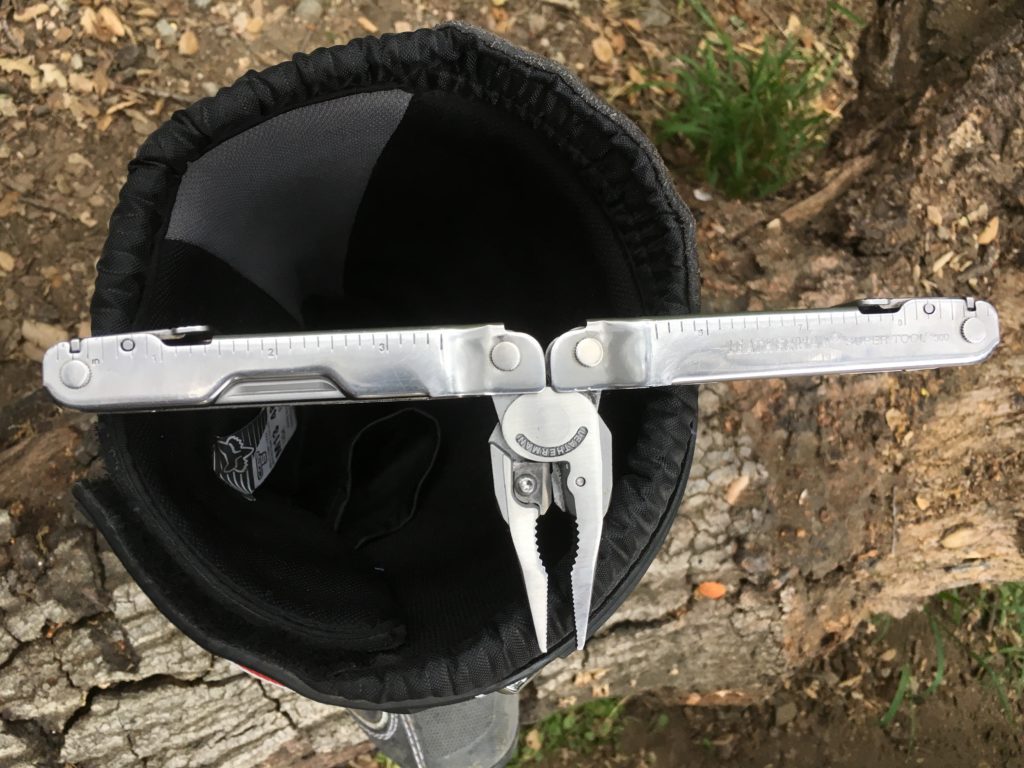
Time and my wallet wouldn’t allow me to shop online and process multiple returns, so I ended up just going with what I could find in-store to try on, and from there had to decide on the type of boot to buy: Motocross style or adventure style.
Motocross:
I ended up buying a pair of Fox Comp 5 boots on sale just because I could afford them at $100, because I needed something in which to learn to ride safely and which actually fit.
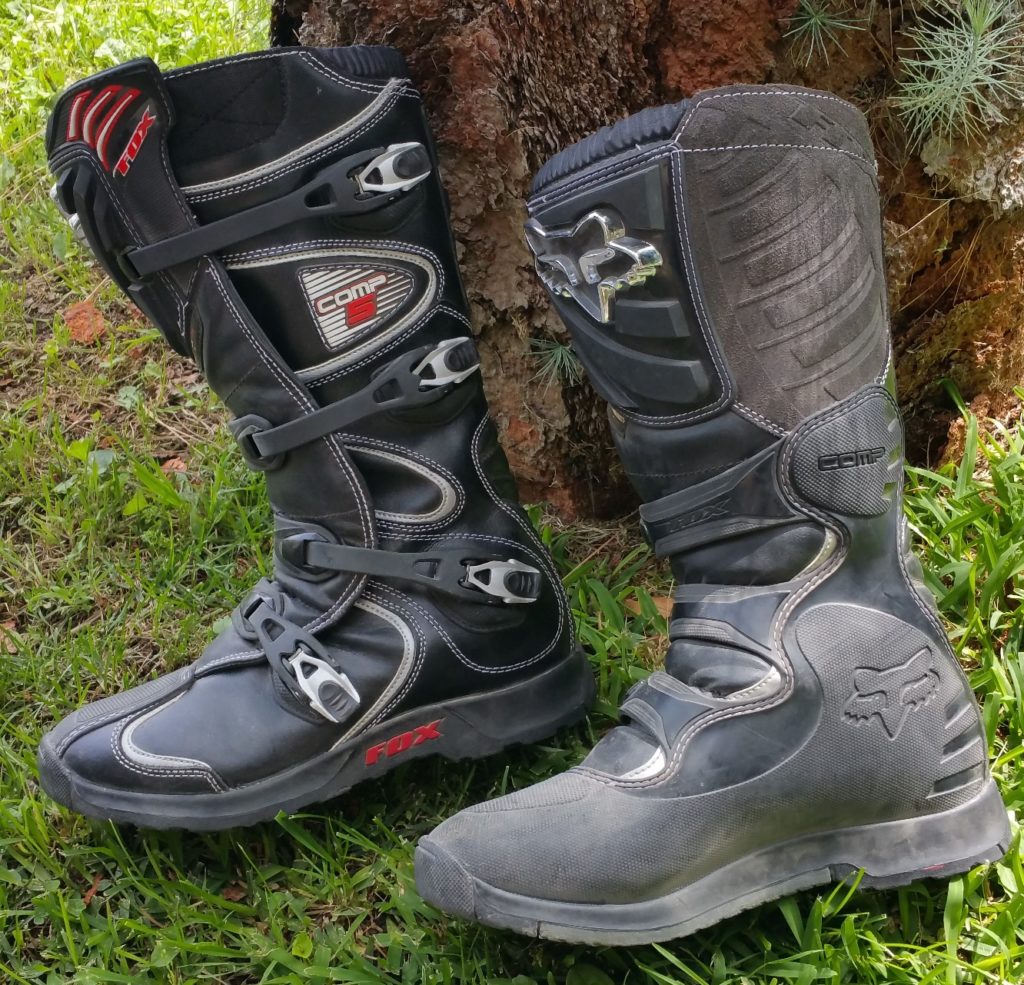
For the two rides I got to use on them before having surgery they worked great. However, I never fully intended to ride them on the TAT because they weren’t waterproof and had a smooth outsole.
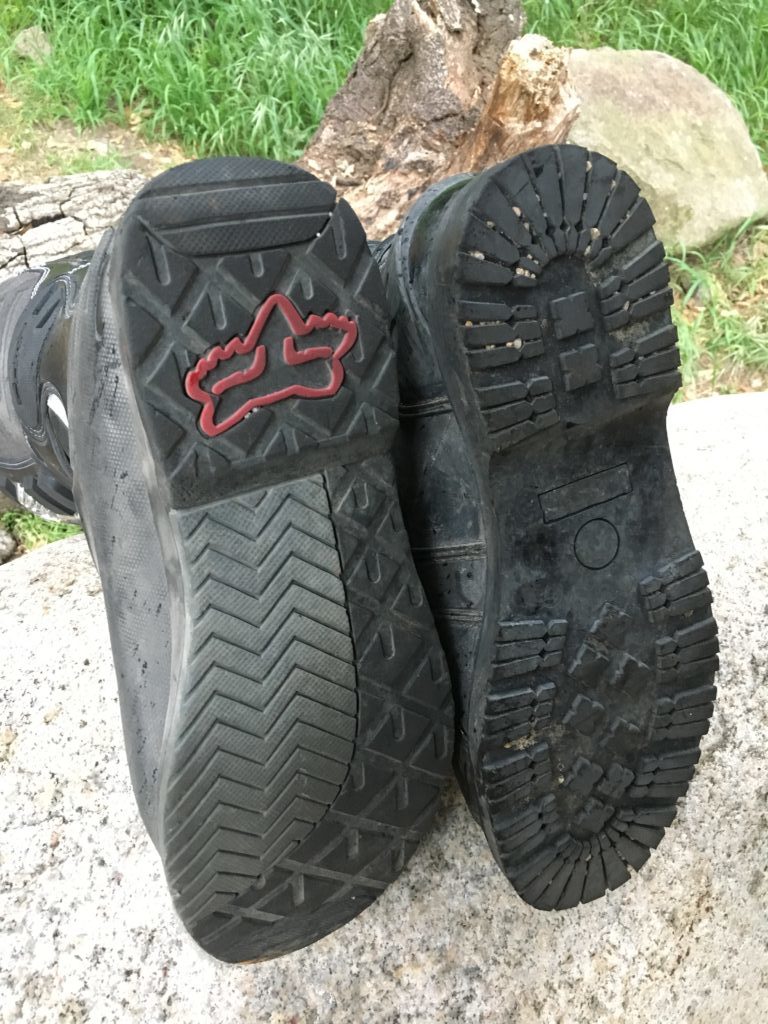
Smooth sole on the Fox at left, Sidi generic lug sole at right.
Note that you can find them with a lugged outsole, but at the time those were all full price and more than I wanted to spend on a pair of practice boots. However, if getting my feet wet wasn’t an issue because I chose to buy Gore-tex socks or had a sag wagon to bring dry spares, these would have been great boots – lug sole only.
The have easy to use latches, are significantly taller and more protective than adventure boots. For the price I paid, I’ll keep them and use them as my beat-around local riding boots because they do work. However, they’re very stiff and the height and overall thickness of the boots can cause issues with outerwear. My only gripe is that they fit oddly for being so large. In the comparison pictures they look a lot bigger in the toe box, but are actually a lot smaller, with my big toenail hitting the top of the shoe. My concern on a longer trip with these would be losing a nail and destroying my expensive, fancy socks.
I can personally vouch from my first dropped bike ever that these work. Bearing in mind that I was a newbie on stock dual sport tires at full pressure and did I mention that I was a newbie on my 2nd dirt ride ever? On what I wouldn’t even consider an obstacle now, I locked up the front tire, skidded the rear tire and dumped the bike on my right leg in a small ditch. The bike frame landed squarely on my leg and I barely noticed. While these don’t have the features of fancier boots, they have enough and I feel safe riding in them in most conditions. Even the smooth outsole has more grip than I expected, although I wouldn’t want to try any mud. If you’re a fair-weather rider, don’t mind getting a little sloppy, or otherwise don’t care about the waterproof issue, these are a great boot for the price, even at $200. But they just wouldn’t work for my trip.
Out of all the boots I tried on – and I tried on dozens – only one other boot even fit my balloon of a calf, and that was the Sidi Adventure Gore-Tex.
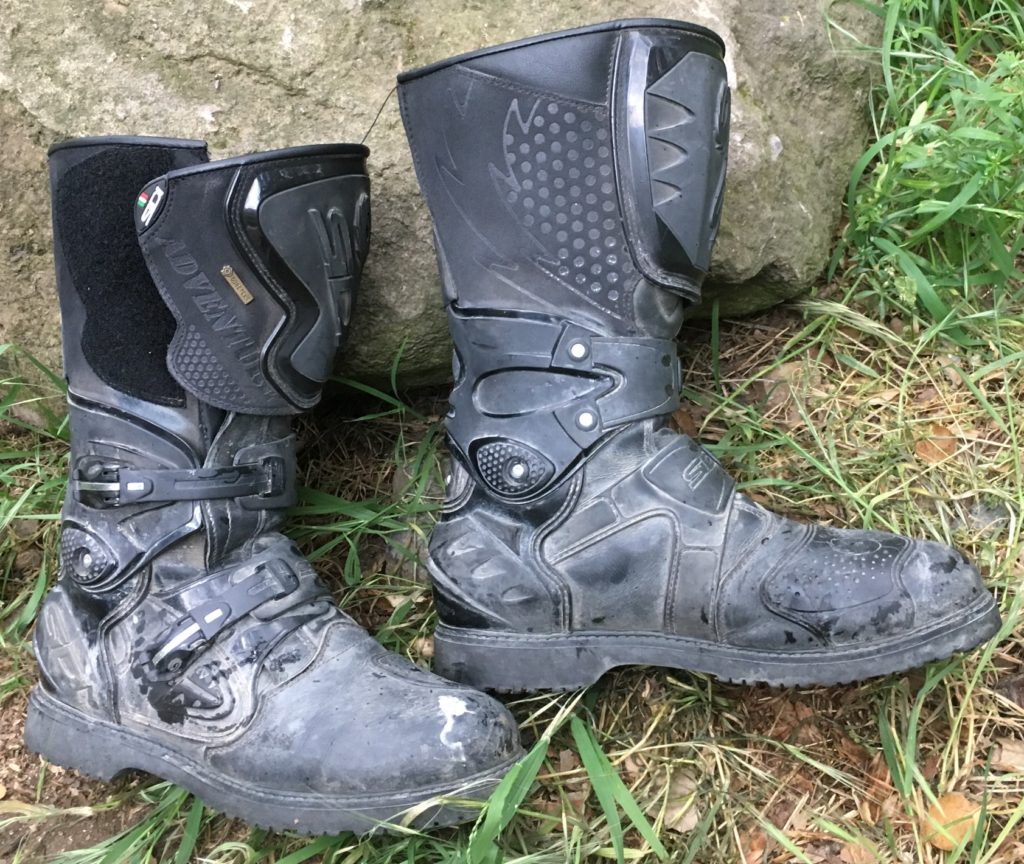
Note that the new version is the Adventure 2, but it’s just the newest edition of the boot. Further, they do make a cheaper version called the Adventure Rain and a less featured boot called the Deep Rain, each about $100 less than the higher version respectively. The Adventure Rain is a carbon copy of the Adventure Gore-Tex, but with a proprietary waterproof membrane instead of Gore-Tex. I did a lot of research and came to the conclusion that no one has ever had their feet get wet in the Gore-Tex version whereas a few people have complained about the Rain version. Who knows how many of the lesser boot actually leak, and it is a minority, but it’s more than the higher boot. I figured since I was already spending $400 on a boot, what was another $100 to get the better waterproofing warranty? Gore-Tex is known for their warranty, but they do charge for it. I wouldn’t touch the Deep Rain or any boot in that category unless I was riding hard-packed gravel roads. Just not enough protection for my tastes.
What a perfect segue. Part of the reason I went with the Sidi – besides my elephantitus calves – was the overall protection, as well as the replaceable soles. Recall that I’m hard on shoes, let alone the additional abuse seen by dual sport adventure riding, so that was a selling point for me. That said, I’m a Vibram fan through and through and sincerely hope I can resole these with a better outsole than came from the factory. Frankly, that’s my biggest gripe about these shoes. For $500, they couldn’t put on the best outsole on the market? While they’re holding up relatively well so far, they are showing wear after less than 10,000 mile of admittedly aggressive riding.
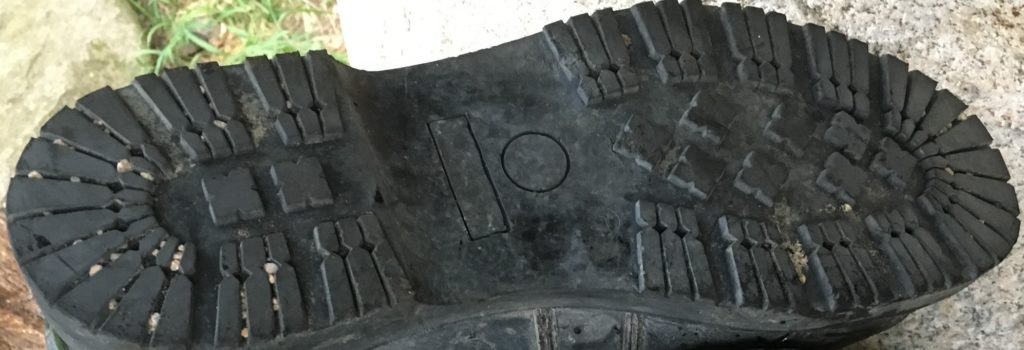
Example of the wear. Then again, this is 6K miles of on and off road and at that rate these should get 3-4x that, so perhaps I’m being too hard on them. Nope, I’m used to Vibram, I’m spoiled.
The Sidi only has two buckles, as compared to the four on the Fox Comps, with the Sidi finishing the top with a Velcro closure. Note how the Velcro section only overlaps by about 1-2 inches, leaving a large swath of fuzzy Velcro hanging in the breeze.
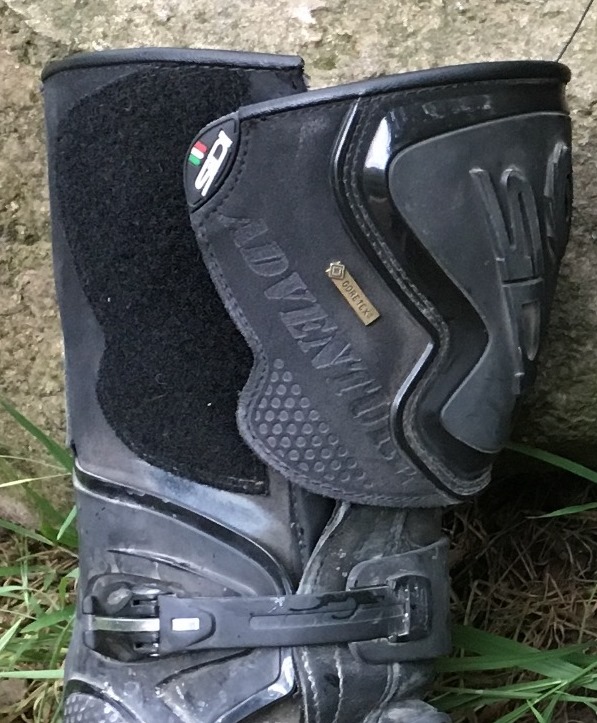
While this same issue is a problem on my Chippewa’s mentioned earlier, it’s not a big deal on the Sidi’s because the Gore-Tex gator comes up high enough that a gap is covered.
Not having a full four straps isn’t a terrible issue due to the nature of the riding and the compromises which must be made. A full race boot is very safe, but won’t allow the same off-bike antics as an adventure boot, let alone be able to handle the varying conditions. Where Sidi makes up for it is by having a very large front plastic bash plate, so impacts and to a lesser extent crushing are mitigated.
While a good portion of the boot is leather, an equally large portion is plastic, but that’s okay for this boot. There’s a raised section in front of the first buckle to force objects to slide over it, there’s a large swath of plastic covering the angle and heel, wrapping around all sides, ending in the buckle itself.
All of that protective plastic has a price, and that’s the famous Sidi squeak. I don’t care who you are, how long you’ve had the boots, how often you clean them and whether or not you oil the joints ever or frequently, your boots will squeak when you walk, and it’s not a small squeak at that. Ever been in a ski lodge and heard the skiers clomping around with heavy steps and squeaks? Take away 70% of the heavy step, keep the squeak. I personally don’t care. Honestly, if I’m wearing these boots, it will be painfully obvious that I’m riding a dirt bike so I’m just playing the part. If you do care, if you’re more concerned about the looks and sound than the performance, look elsewhere but I don’t know of any real adventure riders who care.
Being a premium boot at a premium price, these must perform perfectly in all aspects of their designed purpose or they’re little more than an overpriced and ruggedized version of Jimmy Choo’s. As hard as I am on shoes, I don’t care about brand name, I care about construction. I’ll be the first to tell you that the stitching on the side of the sole is just a rubber impression of a fake welt, but I also know that in certain circumstances a glued sole can be preferable to a stitched sole. Given that the riding shoe must be considered a consumable, and in this case the soles are factory designed to be replaced, I can accept a little stylistic fraud in the overall use of the boot.
With all that, I can comfortably say that these boots performed admirably and perfectly and given the chance, would probably purchase these again. I dropped my bike in the Mississippi mud at 15mph and the boots didn’t notice. I rode through some of the worst rain storms in history without feeling a drop of water leak in. I rode at elevations up to 13,000’ – in a thunderstorm no less – and never once did the boots ever enter my mind. I helped my brother pick up his bike from a large mud puddle, ankle deep in slime while flexing, bending and twisting in every direction underwater, and never a drop.
I am well versed in Cambrelle linings and while I have destroyed both leather and Cambrelle linings in the past, these have held up relatively well. I do see a bulge at the heel of the boots but nothing indicating failure of any sort so thus far have no expectations of any issues.
I do have one complaint, which I find annoying every time I put on the boots. The plastic part holding the top buckle has a lip which is probably supposed to extend over the front of the boot, but in my case always goes under the lip, but starts out just beyond, which means the notches on the strap hit the plastic lip, making closure of the buckle difficult. I always have to work around that and when I do another long trip will probably file down the notches or otherwise modify the boots. The good part is that most of the major equipment on the boots is replaceable, so I won’t cry when I deface my costly boots.
I want to make one major caveat to all of this, to address the more financially frugal or distressed. You don’t need these boots to take a trip as aggressive as the TAT or as light as a weekend ride. Heck, even my concerns about the waterproofing could probably have been dismissed, given the riding gear I have. My riding pants go out over the boots, down to the ankles, so I could probably have just waxed the lower portion of the Fox Comps and been fine in all but the deepest water and even probably then. I will not say that you can do a major ride in hiking boots or similar just due to the lack of protection. You can also ride a motorcycle in flip-flops and shorts or punch a polar bear in the snout, but you probably shouldn’t because the avoidable consequences are too extreme. If that’s you, don’t ride at all, because not only can you not reasonably afford to do so, but you make the rest of us good riders look bad. Otherwise, if I see you on the trail riding the Fox Comps, the Sidis, or any other protective boot, good on ya, ride on my friend, ride on.

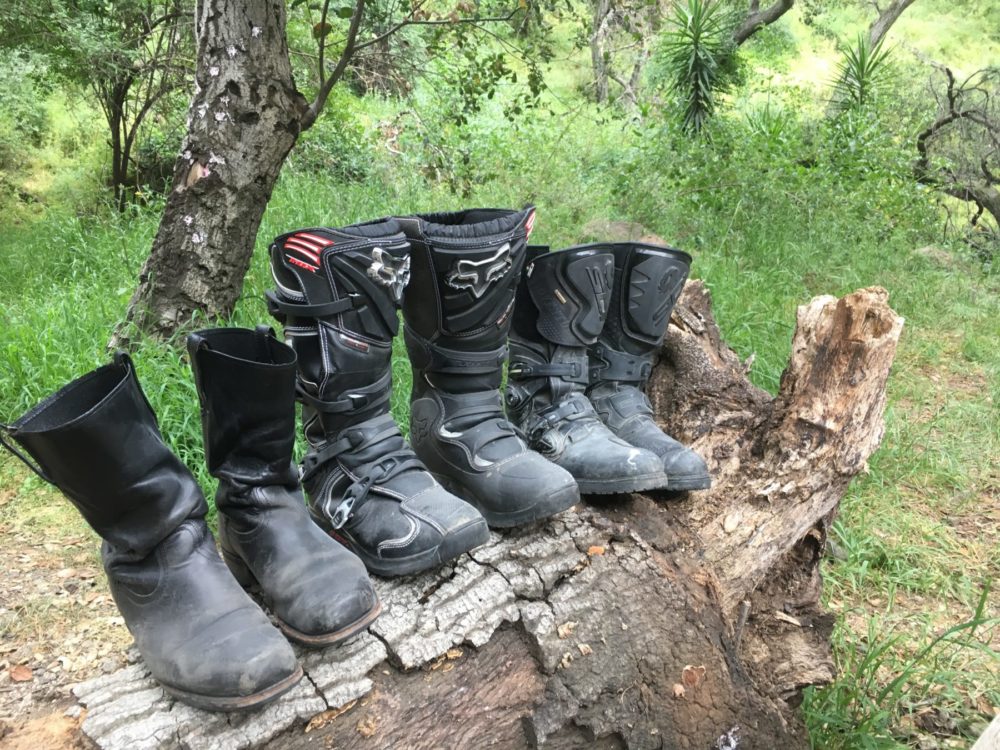




Comments are closed here.